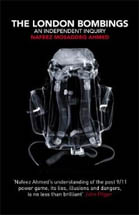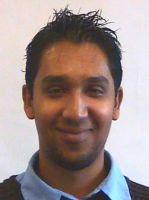Nafeez Ahmed published The London Bombings in 2006 only one year after the event, so he must have completed the manuscript right after the 56-page ‘Official Narrative’ was published by an anonymous Home Office source.
manuscript right after the 56-page ‘Official Narrative’ was published by an anonymous Home Office source.
Ahmed sternly judged this government Report as ‘systematically downplaying the undeniable role of al-Qaeda in the London bombings’ (p275) – for example, it had failed to acknowledge ‘the connection between the 7/7 cell and Haroon Rashid Aswat, believed by both British and US investigators to have been the senior al-Qaeda operative who masterminded the bombings, as established through records of telephone conversations between Aswat and the alleged chief bomber Sidique Khan.’ (p274) For Haroon Aswat, see my Appendix 5d of ToT, ‘MI6 Double Agent from Dewsbury, Leeds’.
His book criticises British intelligence for its supposed ‘appeasement paradigm,’ in the context of the so-called ‘Covenant of Security’ whereby MI5 would in some degree leave alone alleged terror cells as long as they were able to extract info from them. His judgement is fairly damning:
Pre- 7/7, the mounting tide of urgent warnings of an impending terrorist attack on British soil by Islamist extremists did not sway authorities into taking appropriate preventative action.
After the catastrophe, he objects to ‘the ongoing silence on the role of key al-Qaeda officials in 7/7, amounting almost to a form of tacit protection.’ (p260) Why would MI5 want to do that?
After a trenchant critique, Ahmed concludes that ‘Even minor details of the official account remain absurdly impossible,’ and that published official narratives are ‘little more than an insult to the intelligence of the British people.’ (p.282) The police narrative of the four London bombers ‘appears to be based largely on conjecture.’ (p45) One may indeed agree with these judgements – but, why should that be so, if his thesis is correct? And, why would British intel want to downplay a role for Al-Qaeda, if indeed it had found evidence for such?
I’ve never seen any evidence for the four alleged bombers having ‘Al-Qaeda links’ – and I queried Nafeez as to whether he could support the notion of pre-7/7 phone calls between Khan and British double-agent Haroon Aswat (who also lived in Dewsbury). Ahmed argues that the Four became ‘radicalised’ via contacts with the Finsbury Park mosque. But, did any of them ever go there? Ahmed claims that ‘chief bomber Khan is known to have frequented’ that Finsbury Park mosque (p82), and where is his evidence? Possibly Jermaine Lindsey did at one point.
Ahmed argues that ‘Khan and his fellow-bombers were operating within a wider network with links to al-Qaeda and Al-Zawahiri.’ (p53) He criticises the government for ‘implausibly’ averring that the four young terrorists were ‘clean skins’ – who had just decided upon collective suicide by themselves. He finds a terrible failure of British intel – that of not trying hard enough to root out alleged terror networks! After 7/7,
The British based al-Qaeda-affillated terrorist network behind 7/7, although well known to authorities, continues to function intact’ (p259).
In his view, the authorities ‘have continued to suppress the real nature of this network and its frightening international dimensions.’ That is indeed a strange and dire accusation to make against Britain’s security and intelligence agencies. What motive could they have for such treasonous behaviour? There is much on how Al-Qaeda in other countries has been maintained and built up by MI6 and the FBI/CIA, no doubt very edifying.
Many pages of Ahmed’s book appeared as deleted, they were blank. A year later he published a monograph and sent a copy out to M.P.s. This was, he averred, the content of what had been deleted in his book, and it was entitled: Inside the Crevice: Islamist Terror Networks and the 7/7 Intelligence Failure.’ I was at its book launch, at a CAMPACC meeting (‘Campaign against criminalising communities’) Crevice is a code-word for an alleged intended UK terror-plot, ‘thwarted’ by Britain’s anti-terror police before it happened. There is a connection in that one of the ‘Crevice’ suspects, now in solitary confinement Omar Khayam, was photographed together with Sid Khan. So Ahmed was not allowed to publish the ‘Crevice’ material in 2006, the idea being that some court case was still ongoing.
His message to British MPs was that Britain’s anti-terror police were just not doing enough by way or recognising the evil web of al-Qaeda networks and cells in the UK. Melanie Phillips would agree.
This book has no mention of the Bush-Blair meeting at Gleneagles at the G8 summit the day before 7/7, no mention of Peter Power’s ‘anti-terror’ drill synchronising with the bombings at the same stations at the same times; nor any allusion to the motivation of four young alleged-jihad warriors: all centrally-important omissions. Bringing any one of these omissions into focus would tend to cause his entire thesis to disintegrate, in my view.
He does say ‘7/7 was blowback’ (p19) due to then-current UK foreign policies, i.e. indignant Muslims planned it in response to the Iraq war: a position many worthies have adopted, from George Galloway to author Milan Rai. My book ToT was concerned to refute this thesis.
Explosives used
Ahmed believes that the catastrophe took place because international al-Qaeda networks were allowed to flourish in the UK with their message of hate, owing to a misguided British-intelligence ‘Covenant of Security’ made with them. He is therefore inclined to believe the initial version as regards which explosives were used, whereby military-grade ‘plastic’ c4 explosive was detected around the tube train wreckages, possibly purchased in the Balkans by al-Qaeda factions there. Ahhmed is less inclined to believe the later ‘home-made’ explosive story, as having been brewed up in a bath in Leeds. Without wishing to carp unduly, that initial version of the story had detonators remotely-controlled and did not involve suicide bombers.
There is much around the beginning of Ahmed’s book about inconsistencies in the official story, such as evidence that bombs were placed under the tube seats rather than in rucksacks, which has misled many 9/11 truthers to assume that he took their view, and I often find people are incredulous when I assure them that, yes, Ahmed does say that the four young Muslims really did it.
Ahmed is a brilliant and articulate scholar, who may be the main hope for the developing initiative towards a public inquiry, which most Londoners want. He espouses a middle-of-the-road position so to speak and maintains a university lecturing position. I feel he wrote this book rather too quickly, and its entire thesis is greatly mistaken. One would like to hear British Muslim media outlets discussing whether or not they believe in his scary image of a far-flung Islamic terror network, secretly tolerated and in some degree nourished by the UK government, which caused the 7/7 event.
No way could Mr Ahmed could have found a decent UK publisher, held down his job and continued with his PhD, had he chosen to
tell the truth about what happened on 7/7.
The london Bombings, an Independent Inquiry by Nafeez Ahmed 2006

